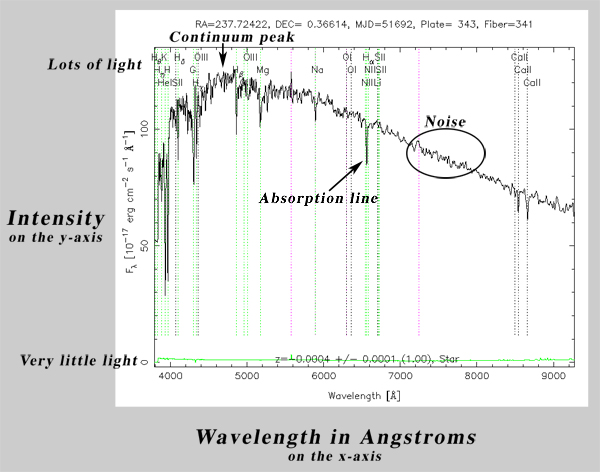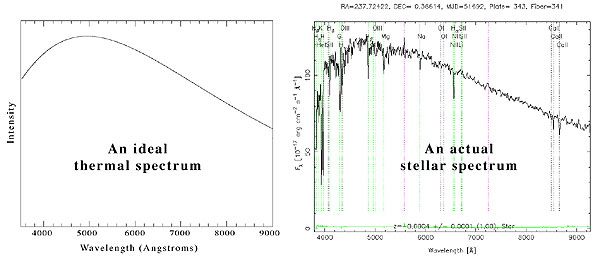A spectrum (the plural is spectra) is a graph of the amount of light something gives off (how bright the object is) at different wavelengths. In the spectra of stars, we frequently do not know the distances to the stars, so a star’s spectrum shows how bright it appears from Earth.
The Sloan Digital Sky Survey (SDSS) measures wavelength in units of Ångstroms (symbol Å), 1 Ångstrom = 10-10 meters. The wavelengths of SDSS spectra go from around 4000 Å (just into ultraviolet light) to 9000 Å (just into infrared light). The scale for the amount of light is complicated, but higher numbers are brighter.
The image below shows a typical SDSS spectrum with some labels to point out several features. Study the image; the text below it describes some of its features.

Some features of the spectrum are:
- Continuum peak – the top of the broad “hill” in the spectrum
- Absorption line – one of the narrow “valleys” in the spectrum
- Noise – some small random fluctuation in the spectrum; noise is usually
much smaller than the absorption lines
The spectrum of a star is composed mainly of thermal radiation that produces a continuous spectrum. The star emits light over the entire electromagnetic spectrum, from gamma rays to radio waves. However, stars do not emit the same amount of energy at all wavelengths.
The peak emission of their thermal radiation (the continuum peak in the spectrum above) comes at a wavelength determined by the star’s surface temperature — the hotter the star, the bluer the continuum peak.
An ideal thermal spectrum is shown on the left below. A spectrum of an actual star is shown on the right.

In addition to the continuous spectrum, a star’s spectrum includes a number of dark lines (absorption lines). Absorption lines are produced by atoms whose electrons absorb light at a specific wavelength, causing the electrons to move from a lower energy level to a higher one. This process removes some of the continuum being produced by the star and results in dark features in the spectrum.
In the actual stellar spectrum, shown above on the right, notice how the underlying shape (the continuum) is a thermal radiation curve with roughly the same peak as the spectrum on the left. The big difference between these two is that an actual stellar spectrum has absorption lines and noise.
